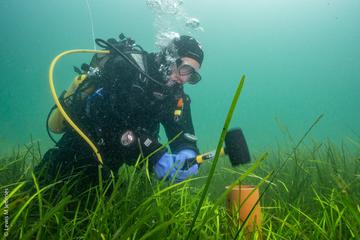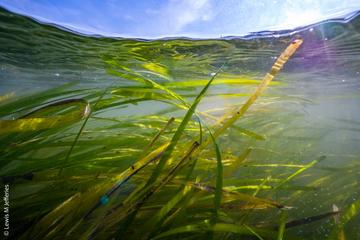Planting the seeds for UK seagrass restoration
Seagrass is a powerful tool in the fight against climate change. Oxford academic Dr Lisa Wedding is working with key partners to lay the foundations for a “seagrass carbon code”, creating a framework for seagrass restoration that will unlock its potential in the UK.
The demand for carbon offsets is growing fast as UK companies work towards their net zero commitments. Blue carbon solutions – using marine and coastal ecosystems to absorb carbon – are an area of growing interest.
The restoration of seagrass meadows provides an exciting opportunity to harness the power of blue carbon. Seagrass occupies less than 0.1% of the world’s ocean floor, yet is responsible for more than 18% of the sea’s carbon storage*. Seagrass meadows also help prevent shoreline erosion, regulate coastal water quality and provide habitat for endangered species. Mechanisms to make the most of this precious resource are currently in the early stages of development in the UK.
Dr Lisa Wedding (School of Geography and the Environment), Prof Nathalie Seddon (Nature-based Solutions Initiative) and postdoctoral researcher Dr Melissa Ward (Oxford Seascape Ecology Lab) have been working with project partners Project Seagrass and ClimatePartner to lay the groundwork for a blue carbon code that will begin to realise this untapped potential.
Laying the foundations

Photo courtesy of Project Seagrass. Copyright: Lewis M Jefferies
Project Seagrass, an environmental charity devoted to the global conservation and restoration of seagrass ecosystems, has been a leading partner in this work. The charity’s extensive knowledge of the UK seagrass landscape and connection to key stakeholders has helped shape the research’s direction to ensure the most useful possible outcomes.
Dr Richard J. Lilley, director and co-founder of Project Seagrass, explains: “This project was about asking — what's the state of play in the UK when it comes to seagrass? What is the existing data, where are the data gaps, who are the people we would need to bring together to make this a reality, and how long might it take? It was about creating a to-do list of things that need to be done.”
“Project Seagrass is one of the primary organisations leading coastal restoration in the UK,” says Dr Wedding. “At the Oxford Seascape Ecology Lab, we work towards developing science-based solutions to support marine management and policy, so it was important to find a partner that could apply our research findings to inform restoration efforts.”
As well as learning more about the ecology and science behind seagrass in the UK, project activities included interviews to understand how companies choose carbon offsetting projects, and engaging stakeholders and the general public to raise awareness of the latest blue carbon science.
Working collaboratively
Iterative conversations with Project Seagrass, ClimatePartner and various stakeholders meant we were able to co-develop our science.
Dr Lisa Wedding
Postdoctoral researcher Dr Melissa Ward did her PhD work in California, where seagrass restoration has been taking place for the last fifty years. She says: “This project was about working out what the UK needs to do, collectively, before a seagrass carbon code can be produced that’s reliable. There is still a lot of scientific data that needs to be collected. And there are lessons from past US failures we can learn from on the UK side.”
Project Seagrass is an organisation with strong academic roots, and Ward worked closely with the team to produce research that would be mutually beneficial.
“We gained a lot in being able to talk through some of the scientific outputs as we were working on the research,” says Wedding. “Melissa was able to have iterative conversations with Project Seagrass, ClimatePartner and various stakeholders, which meant we were able to co-develop our science.
“It was important to our science team that we engaged our partners in a way that enabled us to hone our research so it was more actionable and useful for the key stakeholders and restoration practitioners.”
Working with ClimatePartner allowed insight into the carbon market from the private sector, leaning on both their experience with companies looking to invest in carbon removal projects, and of start-to-finish carbon offset project development. ClimatePartner Sustainability Consultant Sophie Taylor comments: “These partnerships have not only enhanced ClimatePartner’s understanding of the complexities surrounding the science of blue carbon habitats within UK waters, but also emphasised the power that these often overlooked ecosystems have beyond carbon.”
A strong evidence base
As an NGO it’s really important that we’ve got robust data on which to create a case. So you’ve got to go to the best people in the space to get that credibility. That’s how we got to Lisa and the Oxford Seascape Ecology team.
Dr Richard J. Lilley
The aim is to establish a blue carbon code for the UK that will unlock funding for the restoration of seagrass on a large scale. The team hopes to build on this work with Project Seagrass through future seascape restoration research projects.

Photo courtesy of Project Seagrass. Copyright: Lewis M Jefferies
“The journey we’re on as a nation needs to be towards seascape restoration, understanding connectivity in the coastal seascape, and how to prioritise funding and restoration efforts to optimise those efforts,” says Lilley.
“For us as an NGO it’s really important when we’re advocating for a habitat that we’ve got really strong, robust data on which to create a case for seagrass. So you’ve got to go to the best people in the space to get that credibility. That’s how we got to Lisa and the Oxford Seascape Ecology team. Having someone who can put all this into a model and say – this is how you might look to make best use of the resources you have available to you – that’s phenomenal.”
*UNEP report: Out of the Blue: The Value of Seagrasses to the Environment and to People



